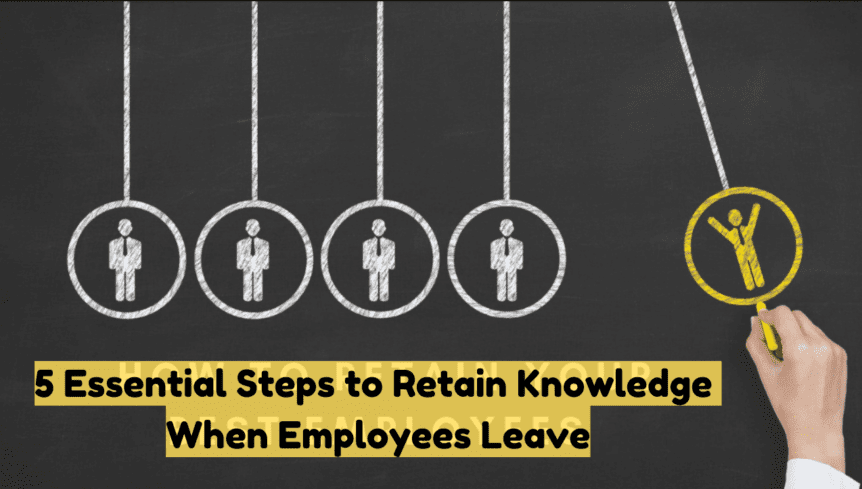5 Essential Steps to Retain Knowledge When Employees Leave
Companies in a range of different industries in the Middle East and around the world are prioritising employee retention. The aim is to keep people with the skills and knowledge you need, as those people are hard to replace. Even with the best employee retention efforts and initiatives, there will still be employees who will retire or leave for new opportunities. That brings another issue into the equation – how do you retain the knowledge that is essential to your business when the inevitable happens and employees leave?
While it is important to have a staff retention strategy, it is equally important to have a knowledge retention strategy. The following five best practices will help mitigate the risk of knowledge being lost to your business due to staff turnover.
Establish a Learning Culture
A key part of retaining knowledge in your organisation is to pass that knowledge on to as many people as possible. What you want to avoid is information silos, where one individual or a small group of people have mission-critical knowledge and capabilities that don’t exist anywhere else in the business.
There are a lot of obstacles that can get in the way of breaking down knowledge silos and ensuring knowledge is spread far and wide. One of the best ways of overcoming those obstacles is to create a culture of learning in your organisation that permeates from the top all the way down to entry-level positions.
Establish a Knowledge Culture
Don’t stop with developing a learning culture, however, as it is also beneficial to establish and nurture a knowledge culture. The features of a knowledge culture include a willingness to share information and having the structures in place to do so.
As part of establishing a knowledge culture, it is important to put in place initiatives to capture learnings and knowledge. Internal project case studies are a good example, where the project is described not just in terms of outcomes achieved, but also on what worked, what didn’t, and what was learned. Another example is to record meetings.
Just like establishing a learning culture, it is important that the building of a knowledge culture comes from the top of the organisation.
Encourage Cross Training and Upskilling
In the modern world, all employees need to continuously upskill to ensure they can add value and adapt to the changing needs of the business.
Cross-training is important too, but it doesn’t always get the same amount of attention as upskilling. This is because cross-training (or cross-skilling) can sometimes be viewed by employees as a sideways move rather than something that progresses a career.
From the perspective of your organisation, cross-training is essential, and it can benefit employees too. We can look to sports and, specifically, rugby to see the importance of cross-skilling.
The number 2 position in rugby, known as the hooker, is a highly specialised position. As a result, teams across the world, from international teams to school-level rugby, have always selected specialist hookers when picking their starting line-ups. If your first-choice hooker gets injured, you bring in the next-best hooker to fill the position.
At the Rugby World Cup 2023, South Africa did something different – it cross-trained a non-specialist hooker as cover for this critical position. And what happened? South Africa’s first-choice specialist hooker got injured in training after the first match, putting him out of the tournament. That left one specialist hooker in the squad and the cross-trained cover.
South Africa still made the final of the World Cup, but the team’s last remaining specialist hooker got injured three minutes into the game. The cross-trained, non-specialist hooker came onto the field and played a significant role in South Africa winning that game and the World Cup.
This example from sport has similarities in business, as new technologies, increasing levels of automation, and changing working practices mean it is more important than ever for employees to be adaptable and multi-skilled – just like South Africa’s non-specialist, cross-trained hooker. As a result, cross-training should become more of a priority.
Identify and Bridge Knowledge Gaps
One of the biggest challenges that companies face when developing a knowledge retention strategy is understanding the key parts of the business that are at risk. Where are the knowledge silos? Where is there a lack of depth in knowledge, i.e., what parts of the business have a small number of employees with the required skills and knowledge?
Identifying these knowledge gaps and then bridging them is necessary to ensure knowledge can be retained in your business even when key employees retire or leave.
Implement a Mentorship Programme
Connecting more experienced staff with new employees is a good way of transferring knowledge, including the types of knowledge that are hard to teach, i.e., the information, tips, and tricks that people learn by being in certain situations, making mistakes, and trying to improve.
A good way of making connections between experienced and newer staff is to establish a mentorship programme.
Retaining Knowledge is an Ongoing Effort
Companies in most industries invest large amounts of money in not only recruiting the right people, but also in providing training to ensure they have the right skills to help the company meet its targets and objectives. Furthermore, the level of collective knowledge in your organisation improves day-by-day simply through standard operations.
Therefore, it makes sense to implement a strategy to retain that knowledge and mitigate the risk of losing it when staff leave. It is an ongoing process, but the effort is worthwhile.
